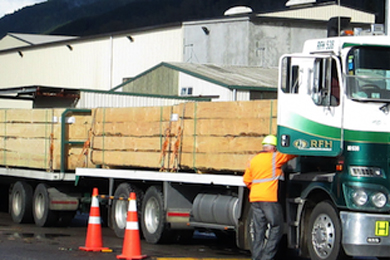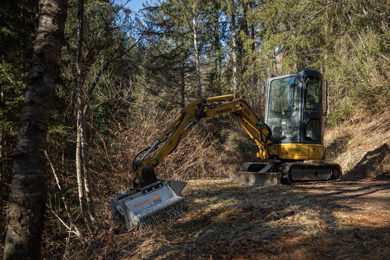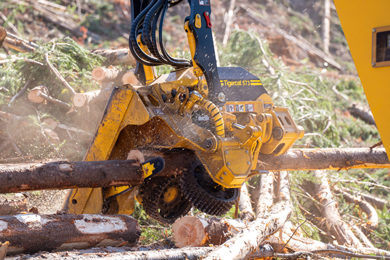The forestry sector says its growth is being unfairly squeezed by competition from subsidised overseas rivals.
Log prices may be good, but foresters say they will struggle to reach bullish export growth targets over the next five years because of subsidies paid to overseas rivals, which may be challenged through the World Trade Organization (WTO). The forest and wood-products industry strategic action plan, published in 2012, set a target to lift exports from $4.5 billion in 2011 to $12 billion by 2022. But exports amounted to just $5.4 billion in the year to June 30.
“I don’t believe that goal is ever going to be achieved,” says Brian Stanley, chairman of the Wood Council of New Zealand, which represents the country’s forest and wood products industry. “It’s pie in the sky now.”
Stanley says most of the export growth was forecast to come from getting more value from logs, but processors, facing price competition from overseas rivals who get government subsidies, aren’t investing. Chinese buyers, in particular, can afford to pay more than local buyers for logs because of subsidies helping to cut the cost of power, transport, land and tax, he says. “If you are manufacturing your sawn lumber in subsidised sawmills, you can afford to pay a bit more for your logs.”
In China, the world’s largest construction market, demand for wood has increased since timber-harvesting quotas were reduced and commercial logging of its remaining natural forests was banned to help protect the environment. As part of the changes, China reduced tariffs on imported logs from 13% to 11%, further widening the margin with sawn lumber, which attracts a 17% tariff.
“They are setting up a supply chain globally of getting logs to China, and so they are coming to places like New Zealand and paying more for their logs than our people can really afford to pay, because the logs are going into subsidised mills,” Stanley says. “We are seeing very little investment in sawmilling, because they can’t compete in the global marketplace.”
In Canada, New Zealand’s biggest rival in the lumber market in China, the Government, which owns most of the country’s forests, requires Canadian sawmillers to be able to buy logs at 60% of the export price, says Stanley. Access to cheaper logs helps Canadian sawmills pay China’s 17% tariff on lumber, making them stiff competition for Kiwi mills.
Source of tension – New Zealand isn’t the only country being hurt by Canadian subsidies, which are an ongoing source of tension with the US under the North American Free-Trade Agreement. This year, in retaliation, President Donald Trump slapped a tariff of up to 24% on Canadian lumber imports.
In New Zealand, the Wood Processors & Manufacturers Association, which Stanley also chairs, wants the Government to consider taking a case to the WTO. The association has taken legal advice on the potential for a case and met Trade Minister Todd McClay and Ministry of Foreign Affairs and Trade (MFAT) officials last month to discuss the issue. “We believe there is an opportunity for New Zealand to go to the WTO,” Stanley says.
McClay says the issues the forestry sector faces are complex and often multifaceted, but he has directed MFAT to invest effort in working with wood processors and forest owners to better understand the challenges they face and find the solutions in the WTO and bilaterally to help level the playing field. “This is an important industry and they have my support to boost exports of value added products via our trade relationships.”
Until these barriers are sorted out, Stanley says, the industry here is not going to pony up with the money needed for new plant that would help drive exports higher.
“Wood processors can’t get access to long-term contracts for logs or raw material, and so nobody is going to invest big licks of money unless they have a guarantee that they have a supply of raw material. The playing field is tilted so heavily against them globally and also locally that they just won’t invest the money to increase the output of sawn lumber or other added-value wood products in New Zealand.”
Forestry products are New Zealand’s third largest export commodity and the prospect of the industry languishing as a low-value commodity producer won’t be welcome news for the Government, which has set a target to double the value of primary-sector exports by 2025, largely through adding more value to the commodities we produce.
One company that has bucked the trend and opened a new mill this year is Red Stag Timber in Rotorua, whose $100 million investment in a “super-mill” enables it to process more than a million logs a year more cheaply. Still, Stanley says that mill has focused its attention on meeting demand in New Zealand and Australia, eschewing bigger markets such as China where it can’t compete.
Potential Opportunities – Stanley isn’t all doom and gloom, though. If trade barriers can be overcome, he sees big potential opportunities for the wood processing industry in engineered wood products, such as cross-laminated timber, which are becoming increasingly popular for multi-storey buildings around the world. They are also gaining traction in New Zealand because recent earthquakes showed wooden buildings outperformed concrete and steel structures.
Dubbed “plyscrapers”, these buildings are attracting innovative big-name designers such as Pritzker Architecture Prize-winning Japanese architect Shigeru Ban, who created Christchurch’s Cardboard Cathedral. Ban’s 19-storey Terrace House project planned for Vancouver is billed as the world’s tallest hybrid timber structure, with a pioneering hybrid structure of wood, concrete and steel.
In Wellington, plans are afoot for the country’s biggest wooden high-rise. Details remain under wraps ahead of an announcement at Parliament.
Given New Zealand’s housing shortage, Stanley sees further potential for the development of other wooden high-rise buildings, and the industry is working with the Ministry of Business, Innovation and Employment to get new building standards in place to smooth the way.
Still, if the playing field isn’t levelled, Stanley believes the outlook for the industry here isn’t that good.
“We have got a tilted playing field globally and we have also got a tilted playing field in New Zealand in terms of competing for our raw materials,” he says. “You are not going to see any step change unless the Government can pull some levers that will make the climate right and level the playing field.”
“We are seeing very little investment in sawmilling, because they can’t compete in the global marketplace.”
Source: Wood Processors & Manufacturers Association (WPMA)







